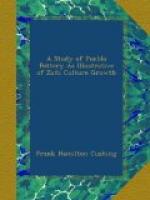EVOLUTION OF DECORATION
I might go on, appealing to language to account for nearly every variety of pottery found existing as a type throughout the region referred to; but a subject inseparably connected with this, throwing light on it in many ways, and possessing in itself great interest, claims treatment on the few remaining pages of this essay. I refer to the evolution and significance or symbolism of Pueblo ceramic decorations.
Before proceeding with this, however, I must acknowledge that I am as much indebted to the teachings of Mr. E.B. Tylor, in his remarkable works on Man’s Early History and Primitive Culture, to Lubbock, Daniel Wilson, Evans, and others, for the direction or impetus of these inquiries, as I am to my own observations and experiments for its development.
The line of gradual development in ceramic decorations, especially of the symbolic element, treated as a subject, is wider in its applicability to the study of primitive man, because more clearly illustrative of the growth of culture. I regret, therefore, that it must here be dealt with only in a most cursory manner. Large collections for illustration would be essential to a fuller treatment, even were space unlimited.
[Illustration: FIG. 542.—Example of Pueblo painted ornamentation.]
Decoratively, Pueblo pottery is characterized by two marked features: angular designs predominate and ornamental effect depends as much on the open or undecorated space as on the painted lines and areas in the devices. (See Fig. 542.) While this is true of recent and modern wares, it is more and more notably the case with other specimens in a ratio increasing in proportion to their antiquity.
[Illustration: FIG. 543. & FIG. 544.—Amazonian basket decorations.]
We cannot explain these characteristics, and the conventional aspect of the higher and symbolic Pueblo ceramic decorations which grew out of them, in a better way than to suppose them, like the forms of this pottery, to be the survivals of the influence of basketry. (See, for comparison, Figs. 543, 544.) I shall be pardoned, therefore, for elaborating suggestions already made in this direction, in the paragraphs which treated of the ornamentation of spiral ware, and of the derivation of basket decorations from stitch- and splint-suggested figures. All students of early man understand his tendency to reproduce habitual forms in accustomed association. This feeling, exaggerated with savages by a belief in the actual relationship of resemblance, is shown in the reproduction of the decorations of basket vessels on the clay vessels made from them or in imitation of them.
In entire conformity with this, the succession in the methods of the ornamentation of Pueblo pottery seems to have been first by incision or indentation; then by relief; afterward by painting in black on a natural or light surface; finally, by painting in color on a white or colored surface.




